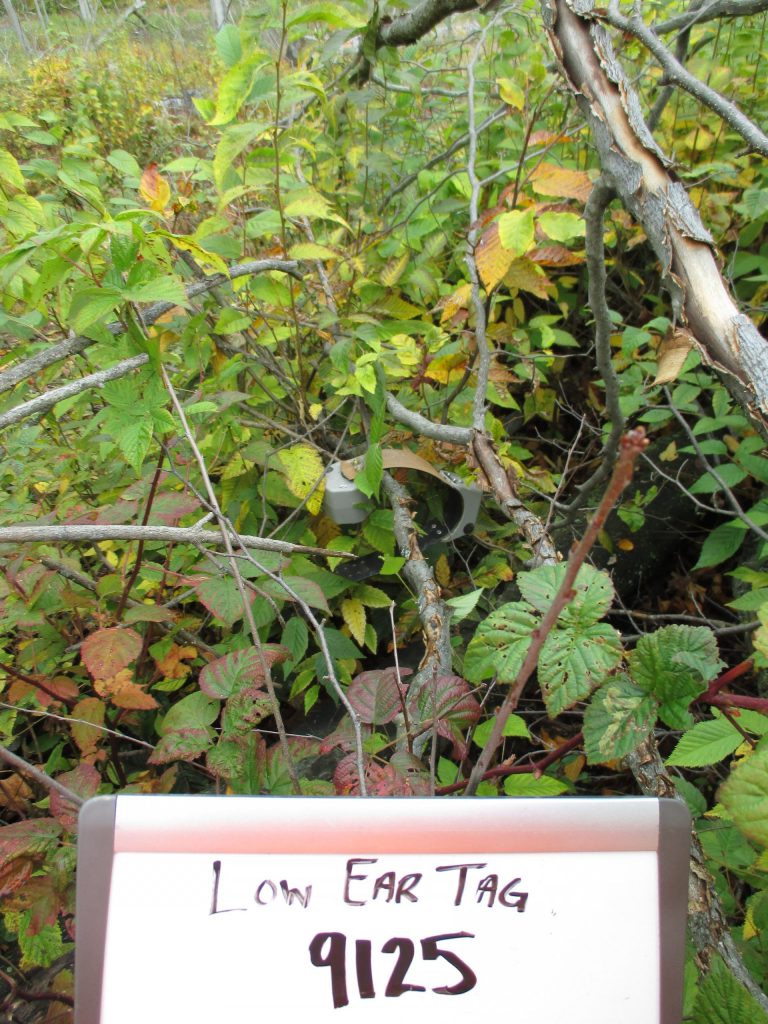Last Saturday evening I received an email in bold red letters – MORTALITY EVENT – from one of our radio-collared deer.
That email meant that the collar on Buck 9125 wasn’t moving and the message indicated it stopped moving at 1:47 PM!
Any number of causes could explain the message.
Sometimes collars fall off but that usually only happens within a week or so after capture. After the initial grace period the deer become used to the collar. Besides, this time of year the antlers should prevent loss of collars.
The other possibility was predation, but predation on adult deer is rare, especially outside the winter season.
The most likely cause of the collar not moving was that it was killed by a hunter. However, this collar was not moving but still in its home range. Usually we get the mortality message and the deer is hanging in the garage or at camp.
Was this an unrecovered kill? Our new field tech, April, had to go discover what happened.
Finding a dead deer can be difficult. You first have to figure out the easiest way to reach the general location of the deer. Once you are in the general location of the collar you then have to use a special receiver and antenna to triangulate on the signal.
Sound easy? Not necessarily. Can you see the deer or collar in this photo? It’s just a few feet in front of you!

Homing in the last few feet to find a collar or deer can sometimes be the most difficult part.
Here’s what April found

The collar was hanging on a dead branch and the locknuts were removed from the collar. We assume the deer is dead.
So we know the deer died by noon on Saturday, most likely during legal hunting hours (we get locations every 3 hours this time of year), and the last satellite location we received was within 7 meters of where it was found.
Was the deer legally killed? Probably, but we don’t know for sure. In our experience illegally killed deer usually have the collar cut. This human was particularly nice in that they didn’t even throw away the nuts!
This situation happens in wildlife research. We have learned to expect it and deal with it. Fortunately, most hunters are cooperative.
Although we have an incomplete picture of the fate of this deer, this event also is an opportunity to remind everyone of the following facts about hunting on the 4 study areas:
- Any deer in the study area can be harvested assuming the hunter has the appropriate license or permit.
- If a hunter has an opportunity to legally harvest a collared or ear-tagged deer (although the ear tags are fairly difficult to see) they should not let the presence of the collar or ear tag influence their decision.
- Not harvesting a collared deer DOES NOT HELP our research! We want collared deer to be harvested like any other deer.
If the hunter who harvested this deer is reading this blog, feel free to call the toll-free number posted on the many signs on the state forest. We’re only too happy to find out about this buck. Or email me. Or have a friend email me. There is no violation for not having reported the harvest to us.
Why some hunters refuse to cooperate baffles me, however. The research we conduct is to learn about deer and deer hunting. Refusing to cooperate with research funded by hunters is kind of like cutting off your nose to spite your face. But we also recognize that some hunters do not cooperate as a way to express their displeasure with deer management in Pennsylvania.
However, by cooperating (and letting us know you hunt deer on the study areas) hunters get an opportunity to tell us about their hunting experiences and express their opinions. Annually, we survey all hunters who register with us about hunting on the study area.
Here’s a video of this buck from when we captured him in late February 2015 until his death on 10 October 2015.
And here’s a slower version of his last few days. He was killed in a clearcut and had moved a total of 250 meters the day before (9 Oct) , 2.6 miles two days before (8 Oct), and 620 meters the day before that (7 Oct).
We are going to classify this mortality as a legal harvest since we have no information to suggest it was illegal. The mortality appeared to occur during legal hunting hours and since this buck was at least 2.5 years old he had a 96% chance of being legal based on antler points of bucks in Potter County. Even if the kill was illegal, its death is associated with the hunting season and represents the loss of deer due to hunting.
-Duane Diefenbach
If you would like to receive email alerts of new blog posts, subscribe here.
And Follow us on Twitter @WTDresearch
